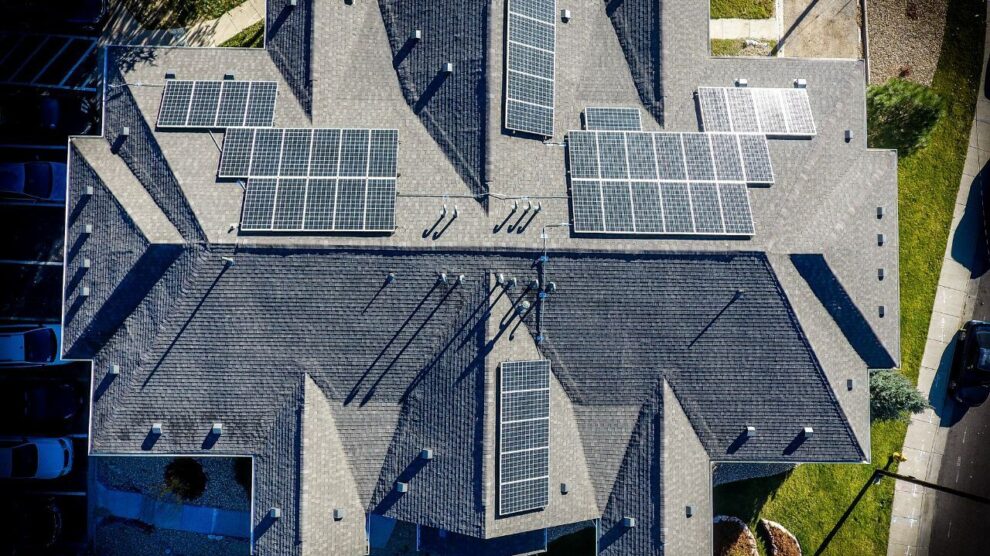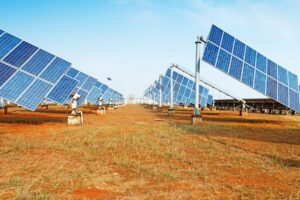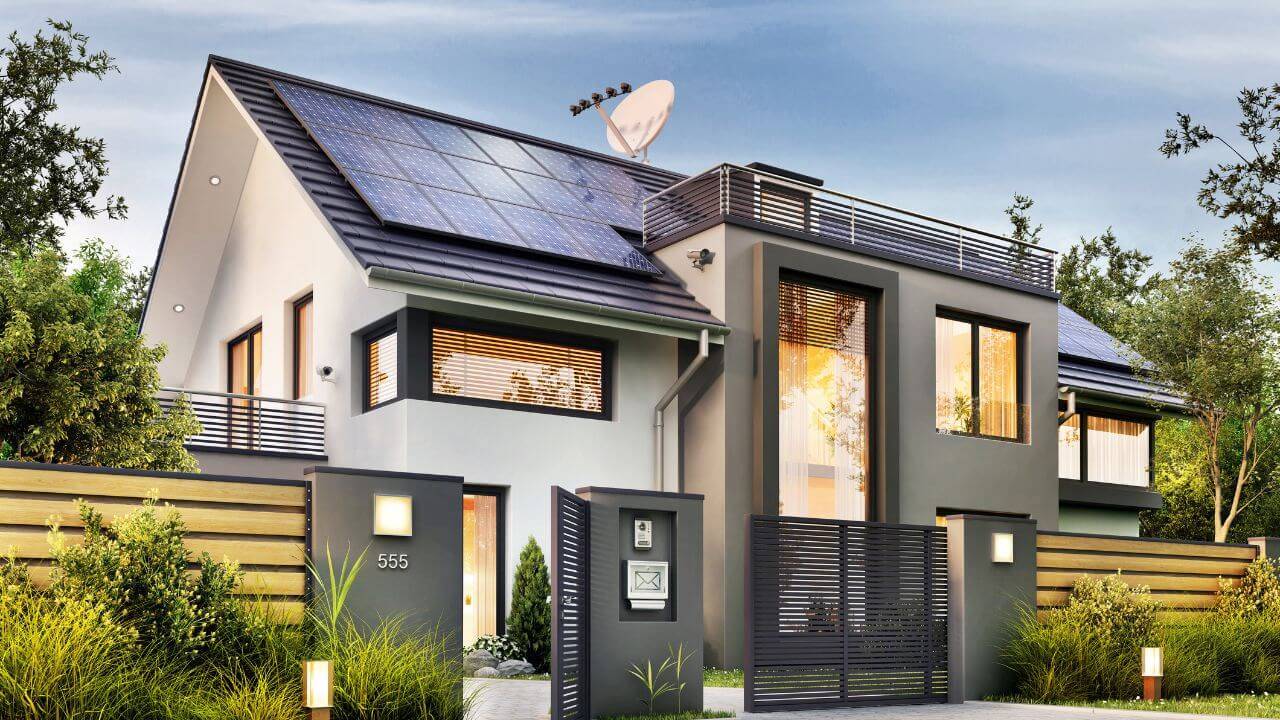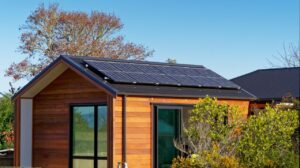Harnessing the sun’s energy using passive solar systems offers an eco-friendly and economical approach to meeting daily energy demands. These systems cleverly utilize natural sunlight using design features and specific materials to gather, retain, and share heat and light, eliminating the necessity for active mechanical devices. The outcome? An eco-conscious and energy-saving method to warm, light up, and cool our living spaces.
With well-thought-out window placements, heat-retaining materials, and effective insulation, passive solar setups make the most out of solar energy all year round. They capture more sunlight during the chillier months while deflecting it during the scorching summer days, ensuring that indoor spaces remain at a pleasant temperature while decreasing the dependency on conventional heating or cooling techniques.
Passive solar systems are key if your goals are to shrink your environmental impact, slash energy costs, or enhance your home’s green credentials. In this piece, we’ll delve into the various passive solar methods, their foundational concepts, and the benefits they usher in. Let’s journey into passive solar energy and uncover the potential of harnessing sunlight for a more sustainable tomorrow.
How do passive solar energy systems work?
Passive solar energy systems function by tapping into the sun’s natural energy to heat, illuminate, and cool our structures. The fundamental idea guiding these setups is to amplify the absorption of solar energy in the cooler months and diminish it during the warmer seasons. This goal is realized through carefully selecting design components and materials adept at capturing, storing, and distributing light and heat.
A pivotal aspect of passive solar energy setups is window positioning. Windows facing the south are generally larger to enhance the solar uptake during winter when the sun is lower in the sky. These windows facilitate sunlight penetration into the structure, where materials assimilate the heat with high thermal mass properties like concrete or water containers. These substances retain the warmth and gradually emit it back into the building as temperatures descend.
Another vital feature in passive solar design is insulation. It aids in curtailing heat dispersion during the winter and averting heat absorption during summer. Passive solar systems can uphold a cozy indoor climate by constructing a thoroughly insulated building shell without resorting to extreme heating or cooling measures.
Benefits of passive solar energy systems
Passive solar energy systems present a myriad of perks for homeowners and individuals occupying buildings. A prominent benefit is decreased energy usage and subsequent financial savings. Taking advantage of the sun’s energy, passive solar setups can considerably lessen the dependency on traditional heating and cooling methods, translating to diminished utility bills.
Besides economic advantages, passive solar energy systems foster a healthier planet by curtailing carbon emissions. Conventional temperature control methods often depend on fossil fuels, which emit greenhouse gases into our atmosphere. Utilizing the renewable power of solar energy, passive solar installations assist in alleviating the impacts of climate change while advancing sustainable practices.
Moreover, passive solar setups augment the comfort of living or working spaces. By securing a stable indoor temperature year-round, inhabitants can relish a cozy ambiance without severe temperature variations. This stability can potentially boost productivity, enhance health, and uplift the general well-being of individuals.
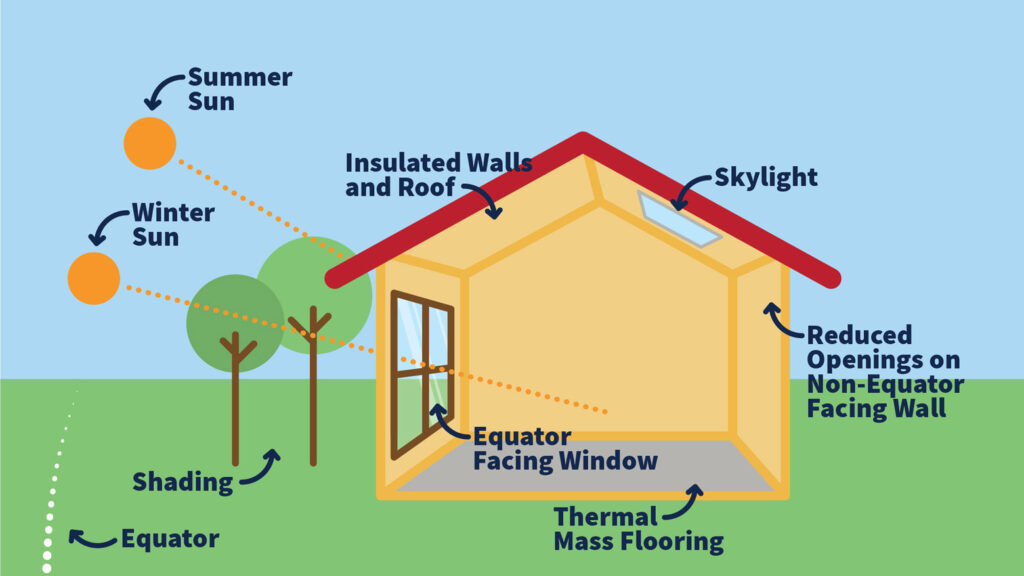
Credit: carbontrack.com.au
Types of passive solar energy systems
Several kinds of passive solar energy systems exist, each tailored to meet the requirements of different architectural designs and regional climates. The prevalent varieties encompass direct gain systems, indirect gain systems, and isolated gain systems.
Direct gain systems function by directly subjecting thermal mass materials to sunlight, facilitating the absorption and retention of heat, which is gradually dispersed into the building when temperatures diminish. This method is particularly efficient in colder climates, whose main objective is to seize and preserve as much solar warmth as feasible.
In contrast, indirect gain systems segregate the thermal mass materials from the occupied spaces. Solar energy is harvested through windows and then relayed to the thermal mass materials by mechanisms like vents or air ducts, enabling a balance between solar absorption and heat circulation. This approach is apt for structures in moderate climates where harmonizing solar gain and heat distribution is the objective.
Isolated gain systems employ a distinct space or structure to collect and conserve solar warmth, utilizing structures like sunrooms, greenhouses, or solar walls. The gathered heat is then channeled to the primary living or working area through openings or vents, providing a controlled and adjustable heat source. This model is prevalent in constructions where solar warmth can be regulated and dispensed according to necessity.
Design considerations for passive solar energy systems
Constructing a proficient passive solar energy system requires thoughtful analysis of various elements. A paramount aspect to ponder is the alignment of the building. Enhancing south-facing windows to accrue maximum sunlight during the winter period is beneficial. Window size and placement should be fine-tuned to balance solar uptake and heat distribution harmoniously.
Thermal mass materials are vital constituents in passive solar configurations. These substances assimilate and retain heat, subsequently emitting it gradually into the structure as the temperature falls. The selection of these materials hinges on various factors, including the regional climate, material availability, and financial considerations, with popular choices being concrete, stone, water receptacles, and even earthen barriers.
Insulation stands as another crucial element in passive solar planning. Adequate insulation curtails heat dissipation during winter and deters heat absorption in summer, employing materials like fiberglass, cellulose, or foam within walls, ceilings, and floors to establish a proficient thermal shield.
Furthermore, considering shading elements is fundamental, especially in regions experiencing hot summers. Structures such as overhangs, awnings, or even planting greenery can be tactically situated to obstruct direct sun rays during the most scorching periods, averting excessive indoor heating and minimizing the dependency on cooling systems.
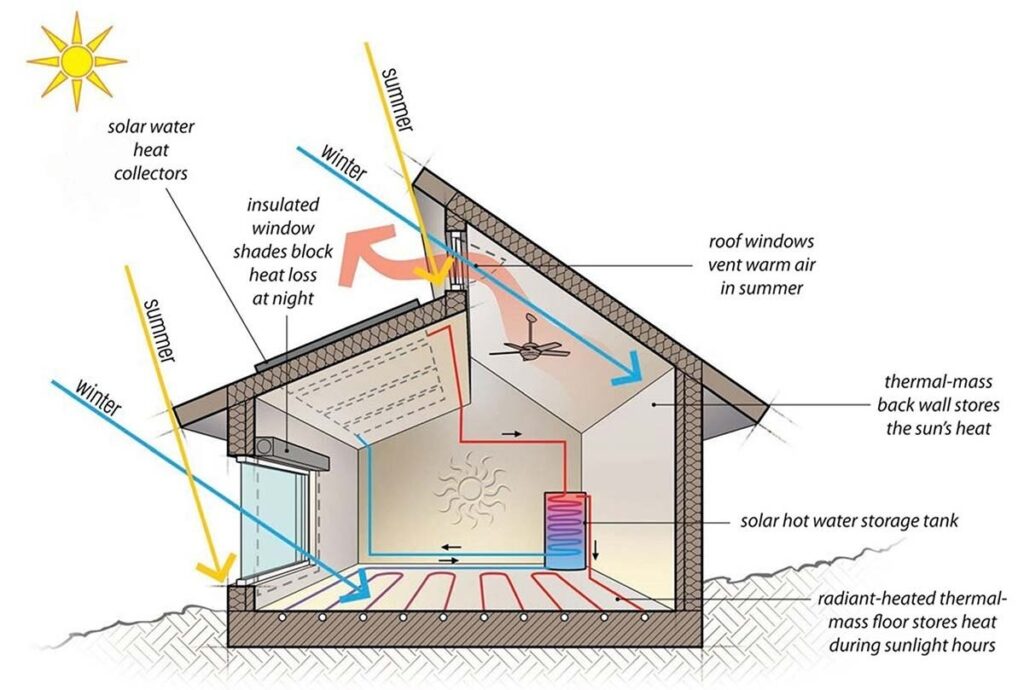
Credit: psci.princeton.edu
Passive solar energy system components
Passive solar energy systems integrate several elements that synergistically exploit and allocate solar energy. These vital elements encompass windows, materials with high thermal mass properties, insulation techniques, shading fixtures, and systems for ventilation.
Windows form a pivotal facet of passive solar architecture. They permit the inflow of sunlight into the structure, offering both natural illumination and warmth. Factors such as the size, orientation, and glazing type of the windows influence the extent of solar gain and the distribution of heat within the building.
Materials with thermal mass properties are tasked with conserving solar heat, releasing it gradually back into the premises as the ambient temperature decreases. Common choices for these materials are concrete, stone, water receptacles, and even structures made of earth. The selection depends on variables like the regional climate, material accessibility, and financial considerations.
Insulation serves as a vital tool in sustaining a pleasant indoor atmosphere. It aids in minimizing heat escape during the chilly seasons and avoiding heat intake during sweltering summers. Various materials, including fiberglass, cellulose, or foam, can be used to construct walls, ceilings, and floors to foster an efficient thermal shield.
Shading instruments like overhangs, awnings, or flora obstruct direct solar rays during peak heat periods, preventing the interior from becoming excessively warm and reducing reliance on cooling systems. These devices can be modified to encourage solar penetration during the cold seasons while offering shade in the summertime.
Ventilation mechanisms are indispensable in preserving indoor air quality and modulating the temperature. Natural ventilation can be facilitated through the use of operable windows, vents, or skylights, fostering a flow of fresh air and aiding in stabilizing the indoor climate.
Passive solar energy system maintenance and troubleshooting
Though passive solar energy systems necessitate lesser upkeep than active ones, periodic assessments and maintenance are imperative to secure optimum functionality. Below are some maintenance chores and troubleshooting guidance for passive solar installations:
- Regularly cleanse windows and shade fixtures to enhance solar energy absorption.
- Periodically scrutinize thermal mass materials for any signs of fissures or damages and undertake necessary repairs.
- Evaluate insulation for potential wear and tear, replacing components if required.
- Keep a close eye on shading appliances, making adjustments as necessary to maintain the desired balance of solar absorption and shading.
- Conduct tests on ventilation systems to confirm the efficient circulation and replacement of air.
- Observe indoor climate and juxtapose it with outside weather patterns to pinpoint any possible discrepancies in heat dispersion.
- Seek expert advice if noticeable temperature variations or system performance issues arise.
Cost considerations for passive solar energy systems
The financial aspect of establishing a passive solar energy system can fluctuate based on variables like the magnitude of the building, the intricacy of the design, and the geographical locale. Although the initial expenditures might surpass those of traditional setups, the enduring savings on energy and the favorable impact on the environment often justify the preliminary financial outlay.
When contemplating the financial viability of a passive solar system, it’s paramount to evaluate the return on investment (ROI). The cumulative energy savings over a period can counterbalance the upfront expenditures, leading to substantial reductions in energy bills. Moreover, various schemes like incentives, grants, and tax reliefs might be accessible to mitigate the primary costs, making the transition to passive solar systems more economical.
Conclusion
Adopting passive solar energy systems brings a plethora of advantages, encompassing diminished energy usage, financial savings, and fostering ecological preservation. Whether your goal is to diminish your carbon footprint, economize on electricity bills, or merely enhance your residence’s eco-friendliness, passive solar energy systems emerge as a feasible alternative.
By leveraging the sun’s natural rays and incorporating architectural facets like strategically positioned windows, thermal mass materials, and insulation techniques, passive solar setups maximize the utilization of solar power throughout the seasons. These arrangements assist in sustaining a cozy indoor environment, lessening dependence on conventional heating and cooling methods.
Before advancing with installing a passive solar energy system, it’s vital to scrutinize factors such as your property’s geographical positioning, alignment, and the prevailing climatic conditions. Engaging with an expert in eco-friendly designs and energy efficiency can assist in evaluating the practicability and economic soundness of such a setup for your particular requisites.
Adopting passive solar energy systems is not solely a stride towards a more environmentally friendly future; it constitutes a prudent venture into enduring energy savings and augmented comfort. Thus, why not harness the sun’s energy and become part of the initiative to transition into sustainable living through a passive solar energy system?

